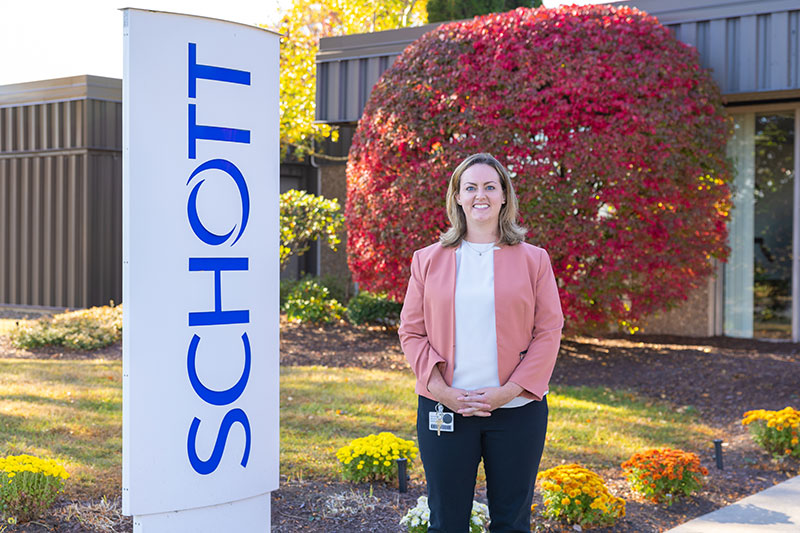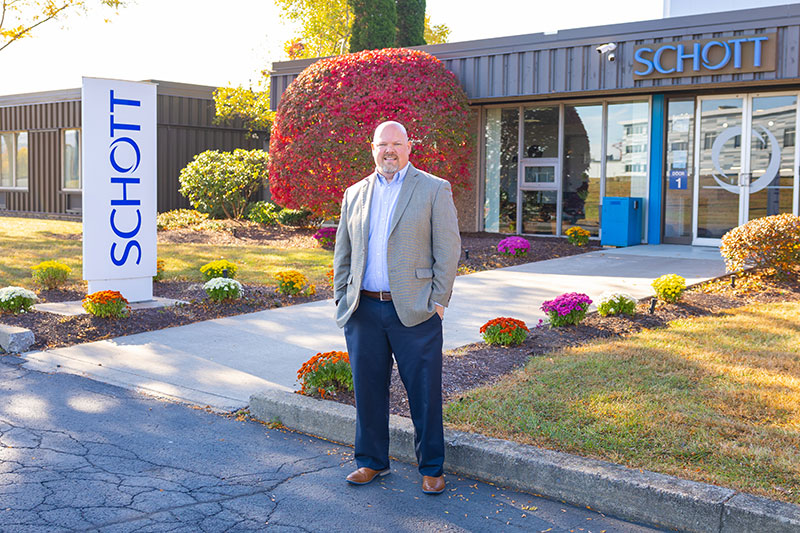In partnership with WVIA, with support from Coterra Energy, we’re bringing you a look behind the scenes at some of Northeastern Pennsylvania’s most successful manufacturing operations. Join us as we get to know the companies, the unique products and the hardworking people leading the way in reestablishing NEPA as a driving force in global manufacturing.
Follow along on this 10-part series that explores NEPA @ Work.
A Global Leader in Specialty Glass Manufacturing and Innovation for 140 Years
In the waning years of the 19th century, Otto Schott, a chemist, Ernst Abbe, a physicist and Carl Zeiss, an optician came together over one shared interest – the seemingly limitless potential of glass. The trio founded the Schott & Associates Glass Technology Laboratory in Jena, Germany in 1884. At the time, their one, true mission was perfecting and mass-producing a better optical glass than what was readily-available.
What the three men accomplished, however, carried them far beyond microscopes. Schott, as the company came to be known, would break open a new world of possibility and innovation in glass. And over the ensuing 140 years, the company would grow to become a global industry leader in the research, development and manufacture of specialty glass applications.

Balancing growth, politics and war
The early 20th century welcomed high demand for specialty glass products and a few decades of innovation and growth for Schott. The company had quickly transitioned from a small laboratory to an industrial powerhouse. In the late 1920s, Schott began to acquire other glass manufacturers in Germany.
Throughout the mid-20th century, in the face of political turmoil, World War II, the division of East and West Germany and the expropriation of all East German industries, Schott faced its most formative adversity. In a moment now widely known as “The Odyssey of 41 Glassmakers,” the company moved into West Germany and built a new plant in Mainz. The plant remains Schott’s global headquarters and primary research & development center today.

Global expansion: Europe, Asia, the Americas and one small Pennsylvania town
In the 1950s and 60s, Schott, now well-established in Germany, began its expansion into Europe, Asia and the Americas. It started with its first global production facility in Brazil. They later added sales offices in key cities like New York, Tokyo and Paris. And in 1969, Schott set up its first major manufacturing plant in North America in the small, suburban borough of Duryea in Northeastern Pennsylvania.
What I’ve experienced over the last 14 years is some of the most creative and innovative people I’ve ever met in my life. The problems that we solve on a daily basis, the application spaces that we play in: medical, defense, space, aviation, they’re not easy problems to solve. And the people that work here in Duryea are fantastic. They’re always up for the challenge. They’re very prideful. They work hard and they’re very smart, hungry and curious. And they’re able to tackle any of the challenges of today, and, quite frankly, maybe more importantly, the challenges of tomorrow.
Planting Roots in NEPA

The “right” people for the job
The arrival of Schott in Northeastern Pennsylvania came on the heels of the dissolution of the region’s coal mining industry. “Duryea was chosen because it had an ample supply of hard-working individuals,” according to Steve Sokach, West Pittston native and Director of Sales for Advanced Optics at Schott. “It was also in close proximity to New York and because of routes 80 and 81, transportation wasn’t a problem,” Sokach continued.

Defying expectations
Initially, the Duryea plant was designed as a high-volume glass melting operation. Slowly but surely over the five ensuing decades, it has evolved into a sophisticated optical components manufacturer. “We host the largest R&D facility outside of Germany within the SCHOTT organization,” boasts Sokach. And the NEPA plant’s reach into the commercial marketplace is practically immeasurable. “Every microchip produced is produced on materials made right here in this facility in Duryea, Pennsylvania,” Sokach said. “Every day, people touch our products at least seven times before they go to bed, or they touch things that our products enable and they don’t even realize it.”

A hub of science, engineering and manufacturing
Today, Schott’s Duryea plant specializes in research and development and technology. Of the current 136 employees, there are sizeable teams of scientists and engineers devoted to solving the problems of tomorrow. It’s a bit of a dream job for R&D Scientist and Lehigh Valley native, Liz Feverston. “You have to be creative because we’re trying to solve problems that nobody has solved before.” She continued, “As a scientist, that’s what makes me excited about what I do here every day.”

It starts with a problem…
The research and development team at Schott approaches their work from two different angles. “Some of the things that we do may be customer-funded,” said Feverston. They’re developing solutions based on the specific needs of a customer. She continues. “It can also be the other way around, too, where we think of something that’s really cool and say, ‘This can help the world in some way.’ And we work to develop it.”
In either instance, the work only begins with the R&D team. The solutions and ideas, the math and science proving their efficacy and most importantly a lot of trust then goes to the manufacturing floor. “There has to be trust that the people you hand that off to are able to scale that up and help you understand and solve the challenges that come with taking something from a research product to a commercial product,” Feverston said. “And our manufacturing workforce really cares about what they do and they’re invested in what they do. That trust goes both ways.”

From Duryea to the global marketplace…
Feverston and her colleagues at Schott develop and manufacture products for the following fields: astronomy, space travel, aviation, sensors, lighting and imaging, targeting systems, laser range finders, digital projection, mobile electronics, smartphone cameras, flat panel displays, machine vision, endoscopy and microscopy. And some of the products shipping out of the NEPA facility include optical glass, infrared materials, radiation-shielding windows and laser glass to name a few.
For Feverston, knowing that her team’s efforts are contributing to making life easier or better in some way is what it’s all about. “I think that the things that we’re doing are finding a home in the world and that’s really important to all of us,” she said.

A big investment in a small town and its people
From a global sense, Schott is a multi-billion-dollar, international company with production facilities and sales offices in over 30 countries. And the research, development and production operation in Duryea has remained one of the most important assets in the Schott portfolio for over 50 years. For Bill James, VP of Research & Development and 14-year Schott employee, that says quite a bit about the quality of the workforce in NEPA and the region’s ability to attract some of the top engineers and scientists in the country.

“Schott, in the future, looks very different than it does today.” — Bill James
Since its inception 140 years ago, Schott has been a future-focused enterprise. For James and everyone at the Duryea plant, their work is driven essentially by two things. First, there’s a pioneering mentality permeating the walls of the science and engineering labs and the machinery on the manufacturing floor. Currently, his team is involved in work on laser glass and its role in energy sustainability and commercial fusion. “We have very inventive and creative people that are coming up with newer chemistries or different chemistries for these glasses,” James said. “And as these materials evolve, there are plenty of applications that are emerging.”
Next to that, the company’s standing as a global leader in specialty glass technology and its long-standing reputation among its customers inspires both confidence and a necessary humility. “And we have a customer base that understands that our quality is really best-in-class,” James notes. “And they have an expectation for our materials to be top-of-the-line or even exceed those expectations.”
In 2015, Schott’s Duryea facility sustained devastating damage in a fire. The parent company, in a vote of pure confidence in the Northeastern Pennsylvania operation, its management and its workforce, immediately invested $20 million to repair and upgrade the facility.
Environmental Responsibility
Since the 1980s, Schott Glass has demonstrated a commitment to environmental protection. From continually improving their manufacturing processes to make them more sustainable to setting goals to achieve 100% green energy production to drastically reducing emissions and waste, Schott has positioned itself as an industry standard-bearer when it comes to sustainability.
In recent decades, Schott has publicly committed to a “Climate Neutral by 2030” plan. This global commitment has served as the company’s overarching goal to lead the industry toward complete climate neutrality.

DiscoverNEPA and WVIA are proud to highlight the tremendous manufacturing organizations and opportunities within our region. We offer a special thank you to Coterra Energy for generously supporting this project.



















